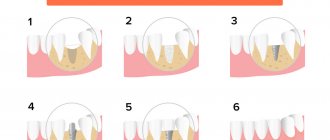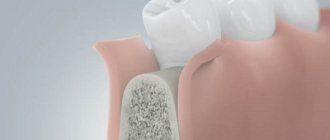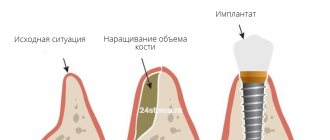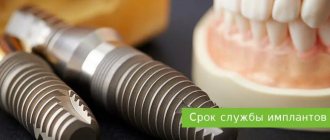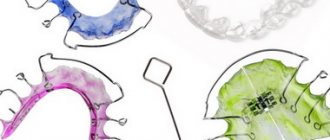Indications for the use of microimplants
- Orthodontic treatment. In orthodontics, mini-implants are used as additional support for a brace system. Their installation is required if selective correction of the position of the teeth is required. For example, if one tooth is displaced relative to its axis or has an incorrect position. However, all other teeth do not require correction. Fixing a brace on an adjacent healthy tooth can lead to the risk of it moving. A microimplant allows you to reduce this risk to zero. It is screwed into the gum and serves as a support for the braces system, balancing the pressure. The teeth move along the trajectory planned by the orthodontist. In this case, healthy units are not affected. After treatment is completed, the rod is removed.
- Orthopedic treatment. In orthopedics, microimplants are used as a support for removable dentures. To fix the prosthesis, it is usually necessary to implant 4-6 microimplants, after which the system copes well with the occlusal load. Due to their miniature size, they take root even in the upper jaw with bone atrophy. The microimplant can be loaded immediately after installation, without waiting for complete osseointegration. Compared to classic implantation, this is a less invasive procedure. Therefore, it is suitable as an alternative to conventional dental implantation for certain contraindications. A microimplant can be installed in case of bone atrophy, contraindications to osteoplasty, or complicated clinical picture.
General overview
The Bioray line of miniscrews is manufactured by Biotech Instrument, headquartered in Taipei, Taiwan. It is worth noting that for the manufacture of implants, steel supplied from Germany is used, as well as equipment from Japanese developers, so the designs can rightfully be considered an international product.
From a technical point of view, a miniscrew is a small-sized element that looks like a screw, the task of which is to form an auxiliary support during the orthodontic correction of row defects. Implants screwed into the bone structure consist of three elements:
- A cone-shaped body of a pointed shape with applied threads located either over the entire surface of the screw or on the lower section;
- A supragingival head in the shape of a mushroom, which includes a groove, a support-ring element and perforations that allow you to secure the power elements of the corrector - springs, elastic rods or ligatures;
- A transmucosal ring located under the head and placed on the area of contact of the implant with the mucous tissue, thereby preventing infection of the bone tissue after installation.
For the manufacture of Bioray miniscrews, anti-corrosion medical steel is used, which has strength characteristics and prevents ingrowth into the bone structure. The model range provides a variety of designs, which determine the technique and area of implant installation.
During the integration process, there is no need for preventive opening of the mucosa, as well as perforation of bone tissue. The duration of correction varies in the range of 4-6 months, after which the miniscrews are removed and can subsequently be used for re-treatment.
Contraindications
Microimplants are less traumatic than conventional implants, but their installation has a number of contraindications. Most of them are not absolute. A final decision on the possibility of installing a microimplant will require examination and, possibly, additional treatment. Contraindications include:
- Diabetes mellitus in the stage of decompensation.
- Inflammation in the oral cavity.
- Gum diseases.
- Loose bone tissue.
- Mental illnesses.
- Oncological diseases.
Microimplants should not be placed on patients who smoke. Smoking slows down the healing process, which can cause various complications and reduce the effectiveness of orthodontic treatment. Therefore, patients who are not ready to give up the habit will have to use alternative options.
Advantages of microimplants in orthodontic treatment
- Reducing treatment time. During orthodontic treatment, the patient wears a non-removable corrective appliance for a long time. The use of microimplants allows you to reduce the time required for bite correction.
- Lightening the braces system. In traditional treatment, additional elements are used to provide a counterweight, which are attached to the braces. This makes the structure heavier and can cause discomfort for the patient.
- Correction accuracy. The pressure force of the bracket system and the speed of tooth movement are planned at the preparatory stage of orthodontic treatment. Since microimplants, rather than your own teeth, are used as support for braces, a more accurate calculation can be made.
- Good survival rate. Despite the fact that microimplants are a relatively new technology in orthodontic treatment, we can already say that they take root well and do not cause complications. There is no risk of rejection, inflammation, or damage to bone tissue. Therefore, mini implants can be used even in patients with thinning gums.
- Installation in the right place. The microimplant is short in length, so it can be implanted anywhere in the gums. On the upper jaw they can be installed next to the maxillary sinuses. There is no risk of damaging them during implantation.
- Easy to remove. For orthodontic treatment, a titanium screw is installed for a period of about six months. After which it is removed from the gums without damaging the tissue.
Areas of use
As already noted, Bio-Ray miniscrews are intended for use in cases where additional anchorage is required. The most common indications for installing miniscrews include the following tasks:
- Distal displacement of the upper and lower fillers is a case when it is not possible to use natural teeth as supporting teeth.
- Vertical displacement of teeth.
- Retraction or protraction of the upper or lower jaw.
The table below presents specific cases in which it is recommended to use miniscrews, supplemented by recommendations for their size and installation location.
| Indication | Installation location | Screw size | Note |
| HF protraction | IZC | A-1 IZC 2×14 mm | — |
| Palatal impaction of canines | Sky | A-1PL 2×12 mm | — |
| LF retraction | B.S. | A-1PL 2×12 mm, A-1PL 2×14 mm | — |
| Impaction of the maxillary canine | IZC | A-1 IZC 2×14 mm | Combined with 3D lever |
| Impaction of the mandibular canine | B.S. | A-1PS (with torque) 2×12 mm | Combined with 3D lever |
| Impaction of the mandibular molar | LF branches | A-1 IZC 2×14 mm | — |
| LF protraction | B.S. | A-1PL 2×14 mm | — |
| Gummy smile (premaxillary intrusion) | Between the roots of the incisors | A-1PL 1.5×8 mm | — |
Advantages of microimplants in prosthetics
- You can do without bone grafting. For primary stabilization of the implant, a sufficient amount of bone tissue is required. If a tooth has been lost for a long time, the bone will atrophy. A traditional implant can be installed only after osteoplasty. Microimplants require less bone volume, so they can be implanted in patients with bone atrophy.
- Can be used for immediate load protocols. The microimplant is able to withstand occlusal load normally. Therefore, such systems can be used for implantation with immediate loading of a lightweight adaptive prosthesis. Immediately after the operation, the patient can lead a normal life, following the doctor’s recommendations.
Installation of a microimplant is a minimally invasive procedure. The rod is screwed through a puncture in the gum, so there is no need for suturing. The risk of infection, rejection, and peri-implantitis is minimal.
Implantation stages
Just like before classical implantation, the installation of microimplants requires a preparatory stage and diagnostics. The implantologist prescribes an instrumental examination: x-ray, panoramic image, computed tomography. The images help to assess the location of teeth and their roots, the volume and density of bone tissue. Using the images, the doctor makes 3D modeling and plans the operation.
Oral preparation will also be required. It is necessary to undergo examination by a dentist. If caries or other oral diseases are detected, they are first treated. If there are contraindications, consultation with a specialized specialist may be required.
If there are no contraindications, the doctor will prescribe the procedure. The implantation of microimplants is a minimally invasive operation that takes about 15 minutes. The installation is done under local anesthesia. In some cases, if there are indications, for example, the patient’s panic, sedation is used.
The surgical stage does not require cutting the gum and its subsequent suturing. The implantologist makes a small puncture into which a screw is screwed. Since mini-implants have good primary stabilization, an orthodontic appliance or an adaptive prosthesis can be installed immediately.
After completion of the procedure, the doctor will give recommendations for oral care. If necessary, he will recommend anti-inflammatory and painkillers. Despite the fact that the implantation of microimplants is a gentle, low-traumatic procedure, in the first days there may be pain, swelling of the gums, and slight bleeding. These are normal phenomena that will go away on their own within 2-3 days.
Typical apparatus design
The design of each device directly depends on the individual characteristics of the patient (jaw structure) and the problems with which he turned to a specialist. A standard twin block orthodontic appliance (Clark appliance) consists of the following parts:
- Base plates. This is the basis of the device, which has a direct effect on the gums and muscles. Due to the plates, incorrect occlusion is corrected. They are made individually, taking into account not only the specifics of the pathology, but also the anatomical structure of the maxillofacial apparatus.
- Leveling arcs. They are made of metal and are designed to set the base plates in motion. Leveling arches provide the required tension force, the level of which is adjusted using screws as treatment progresses.
- Screws. They perform a fastening function and are necessary for setting and further monitoring the required level of compression of the plates. During the entire treatment period, specialists manually adjust the location of the screws.
How do microimplants differ from traditional implantation systems?
The main design difference is the size of microimplants. They are much smaller than traditional implant systems. They also differ in purpose of use. Their main purpose is orthodontic treatment. This is a temporary structure that will act as additional support for the braces system. After treatment is completed, the screw is removed from the gum. In prosthetics, microimplants are used to fix lightweight removable dentures when it is not possible to do full-fledged dental implantation.
Dental implants are intended for the treatment of edentia, including complete edentia. They replace the root of the tooth and serve as a support for a fixed prosthesis. Good survival rate and long service life are very important for dental implants. Micro implants are usually removed several months after treatment is completed.



